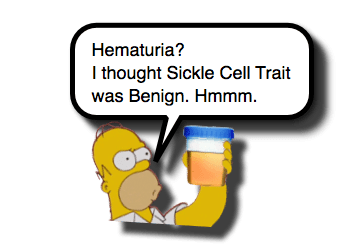Sickle Cell Trait

Sickle Cell Trait
- Sickle Cell Trait = inheritance of one normal hemoglobin gene (HgA) and one sickle hemoglobin gene (HgS).
- It is estimated that Sickle Cell Trait affects ~ 300 million people worldwide. [Tsaras, 2009]
- HgS leads to red blood cell sickling and polymerization under certain circumstances:
- Tissue Hypoxia
- Acidosis
- Dehydration
- Increased Viscosity
- Hypothermia
- The severity of sickling is lower in individuals with lower HgS concentrations.
Sickle Cell Trait: Benign?
- Sickle Cell Trait is commonly considered benign and protective.
- Benign:
- Have similar hemoglobin / hematocrit levels as those without a hemoglobinopathy
- Similar life expectancy
- Able to donate blood similar to others
- Protective:
- Sickle Cell Trait confers protection against falciparum malaria.
- It does not protect against other malarias (Plasmodium vivid, Plasmodium oval, or Plasmodium malaria).
- Benign:
- Complications associated with Sickle Cell Trait are relatively rare, but, importantly, do occur. [Chapa-Rodriguez, 2015; Khan, 2014]
Sickle Cell Trait: Complications
- Hematuria
- Most frequent complication [Tsaras, 2009]
- Both microscopic and macroscopic is seen. [Chapa-Rodriguez, 2015; Khan, 2014]
- ~50% of cases are due to renal papillary necrosis.
- Kidneys promote sickling: [Alvarez, 2015]
- Renal medulla has low partial oxygen pressure
- It is hypertonic and acidotic, which both encourage sickling.
- Leads to microinfarctions in the renal medulla
- Renal Medullary Cancer
- Rare, but aggressive, malignant tumor
- First described in 1995 (so our understanding of its epidemiology is nascent)
- 217 cases known of to date [Alvarez, 2015]
- Almost exclusively seen in Young patients with Sickle Cell Trait
- Median age = 22 years
- Range = 5 – 69 years
- 88% of cases occurred in patients with Sickle Cell Trait
- Presents commonly with flank/abdominal pain and/or hematuria.
- Median survival is 15 weeks.
- Splenic Infarction
- More common in setting of low oxygen tension at high altitudes. (See NFL Players and Denver story)
- Most cases are mild, but may lead to Acute Splenic Syndrome – Severe Pain, Splenomegaly, and LUQ tenderness.
- Splenic Rupture may occur.
- Hyposthenuria
- Hyposthenuria = relative inability to concentrate urine.
- Due to repetitive microinfarctions (Again, kidney’s and sickle hemoglobin don’t like each other).
- Leads to loss of free water.
- Likely contributes to exertion-related illness and death.
- Exertional Rhabomyolysis
- Heat Stroke
- Exertional-related Sudden Death
Moral of the Morsel
- Sickle Cell Trait confers its own unique complications – the concept of sickle cell trait being benign is a myth.
- Hematuria in a patient with sickle cell trait deserves attention.
- Is this renal stone?
- Is this renal papillary necrosis?
- Or… is the the rare, yet particularly lethal Renal Medullary Cancer?
References
Alvarez O1, Rodriguez MM2, Jordan L3, Sarnaik S4. Renal medullary carcinoma and sickle cell trait: A systematic review. Pediatr Blood Cancer. 2015 Oct;62(10):1694-9. PMID: 26053587. [PubMed] [Read by QxMD]
Chapa-Rodriguez A1, Dighe D, Giordano L. Severe anemia in an adolescent male with sickle cell trait: a case report. J Pediatr Hematol Oncol. 2015 Jan;37(1):e60-2. PMID: 25089603. [PubMed] [Read by QxMD]
Khan U1, Kleess L2, Yeh J2, Berko C2, Kuehl S2. Sickle cell trait: not as benign as once thought. J Community Hosp Intern Med Perspect. 2014 Nov 25;4(5):25418. PMID: 25432648. [PubMed] [Read by QxMD]
Li EJ1, Carroll VG2. Sickle cell trait and renal papillary necrosis. Clin Pediatr (Phila). 2014 Sep;53(10):1013-5. PMID: 24807983. [PubMed] [Read by QxMD]
Tsaras G1, Owusu-Ansah A, Boateng FO, Amoateng-Adjepong Y. Complications associated with sickle cell trait: a brief narrative review. Am J Med. 2009 Jun;122(6):507-12. PMID: 19393983. [PubMed] [Read by QxMD]



I had the same thought about the association of hyphema and sickle cell trait. See Nasrullah A et al Am J Ophthalmology 1997. Sickle cell trait as a risk factor for secondary hemorrhage on children with traumatic hyphema. Our ophthalmologists screen for trait among this patient population. More likely to hospitalize if trait present.
Mark
What about higher risk of hyphema in blunt eye trauma.
Eugene
Toledo Ohio
Great question!
The Tsaras paper goes through many other issues that are often spoken of as being associated with Sickle Cell Trait. Hyphema is discussed in that paper as a “Probable Association”… the Morsel only covers the Definitively associated.
The rest of that article is filled with interesting details and I encourage you (and everyone) to review it.
Thank you,
Sean